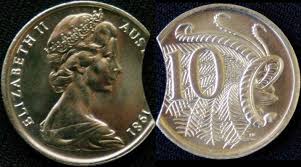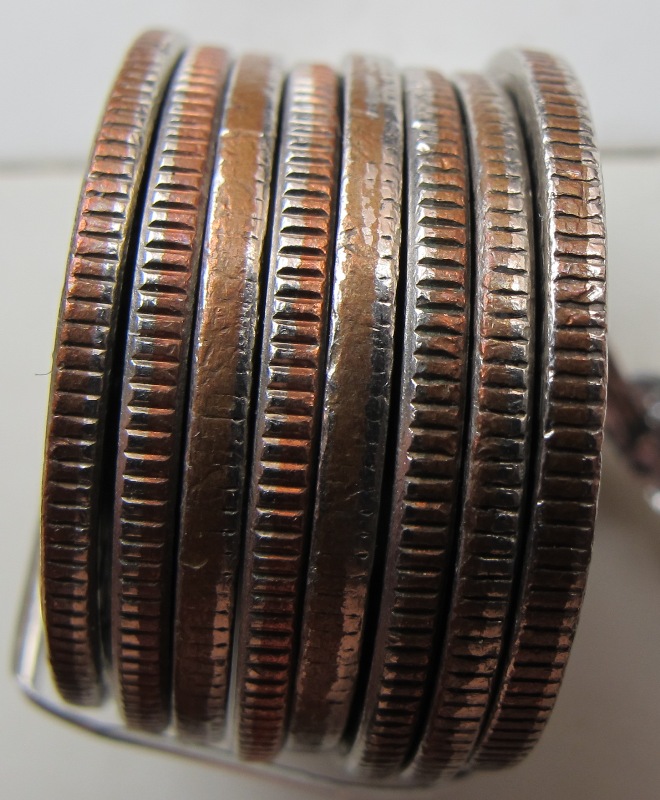OK so let’s dive in a bit more from our last post on error coins, specifically on planchet errors.
Three of the nine listed varieties have to deal with planchet. So definition time. A planchet is a round metal disk that is all set up and good to go to be struck as a coin (older terms are flan or blanks). It is the last step of the material before it is struck into a coin.
Backing up a bit, for the US Mint (but is pretty standard across the board), how a coin is made, in very very simple terms (and here is a lovely video of the process)
- Blanks are punched from sheets of metal in a blanking press (fun fact, sheets are 13 inches wide and 1,500 feet long)
- Blanks are heated in an annealing furnace to soften them, then run through a washer and dryer. This hardens the blanks.
- Blanks are sorted in a “riddler” to screen out any that are the wrong size or shape. Basically, a step just to correct the below issues!
- Blanks are sent through an upsetting mill, to create a rim around the edges (now they are planchets)
- Planchets are struck in a coining press. This is done by a planchet being fed in between two dies and then massive amount of pressure is placed on the press (hence the name) Boom a coin is born!
- Coins are spot checked for errors.
- Automated machines count and bag coins for dispersal.
So these errors happen at the first or fifth stage.
Blank Planchet
The planchet (blank) is not struck, but still makes it through all seven stages. These errors may or may not have rims, with the rimless ones having a bit more value, as they made it through one more step without getting pulled. Far left has a rim, right does not.
Clipped or Incomplete Planchet
According to the “bible” (aka the Red Book) if a coin is not whole, missing 10-25% of its material, is is called a Clipped Planchet. Now if anyone out there knows what it is called if it is under 10% or over 25% I would love to know, and am so asking this summer at ANA Summer Seminar, as I have seen these at shows and for sale….Anyhoo… This is caused when in the blanking press one of a few things happen. The value of these coins depend on the size and location of the clip.
Incorrect Thickness
The sheets that we talked about earlier, (13 inches wide and 1,500 feet long), well they are created by rolling out metal into the sheets. Sometimes mistakes are made, and the resulting sheets may be too thick or thin. As US coins are supposed to weigh a certain amount, and the variation within any mintage is quite narrow, if the planchets are incorrect, this is an error. To the eye, they may appear ok, but generally, even by sight they are “strange”. A planchet that is too thin will show the reverse die on each side “bleeding” thru. One that is too think may not show as much detail and look “muddy”. If a sheet has been rolled with an indentation on it, it will also throw off the correct weight.
Lamintation
Just as the previous section dealt with the sheeting being rolled out, lamination errors occur at the sheet level. If a foreign substance gets into the sheet, if there are impurities in the metal, or if the internal stresses in the makeup are too much, the metal can “peel off”. Discoloration, splitting, uneven surfaces, and yes, peeling, are the result of the error inside the planchet.
Wrong Planchet
This is the most interesting of the planchet error, at least, to me. This is where the planchet for one domination is stuck with the die from another. To put it a bit easier, a penny strike on a nickel planchet, or dollar on dime planchets.
Another wrong planchet error that is due to human error is when the mint changes the make-up of the coins. They adjust the alloy composition of the planchet. Some of the older planchets are fed into the coin press with the new dies. This is also quite rare, with the most obvious example being a 1943 copper cent or a 1944 steel cent.
The last kind of wrong planchet error is an older error, and incredibly atypical. In the 17th-19th centuries, sometimes a planchet from a foreign country was put into a US coin press. Opps!
Cladding Error
Lastly, as it is the results of the modern minting process, is clad errors. Modern US coins are made from layers of different metals. Most have an inner core of copper, and outer layers of a nickel-copper alloy that is silver colored. Think dime, quarter, half dollar. In fact, the modern “gold” dollar coins (Sacagawea and Presidential) are surprising, not gold, but a copper core with clad layers of zinc, nickel, and manganese. Don’t believe me, look at the edge of your coin, and there it is!
Anyhoo, if the process did not work correctly, the layers can fold, peel, or in some cases completely separate
Another great source of explicit detail on errors is here at the Error-Variety Ready Reference.
Up next will be striking errors….ohhh exciting!











